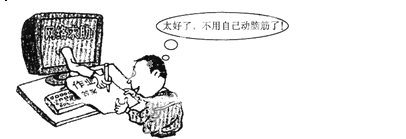题目内容
【题目】书面表达

请观察所给的图画并根据你对该图画的理解写一篇英语短文,内容包括:
(1)简要描述图片,并说明该图片所揭露的现象;
(2)分析造成该现象的原因(至少两点);
(3)提出自己的看法。
要求:1.词数150左右。开头已经给出,不计入词数;
2.文章中不得提及考生所在学校及本人姓名。
The Internet has long been regarded as a wonderful tool that allows students to gain insight to useful resources and information. However, this is not always the case.
【答案】
As is vividly shown in the picture, a boy is happy with the fact that he can depend on the Internet to finish tasks without any difficulty. It mirrors a common phenomenon. Nowadays, students tend to make use of the Internet to gain information they need.
There are some reasons accounting for it. To begin with, students find it convenient to surf the Internet for useful information, where problems can be solved with the help of several clicks. What’s more, there’s no doubt that the pressure to succeed also causes students to turn to computers for accurate answers. As a result, it’s likely that students will lose interest in studying, which is not beneficial to their overall development.
In my opinion, measures must be taken to solve the problem. Firstly, it is vital that students gain confidence in themselves and their abilities while doing tasks. Besides, what teachers and parents should do is encourage students to be creative. Finally, doing tasks independently is of great significance.
【解析】
试题分析:本文是一篇议论文,要求根据所给的图画表达出自己的理解。内容包括:(1)简要描述图片,并说明该图片所揭露的现象;(2)分析造成该现象的原因(至少两点);(3)提出自己的看法。写作时不要逐句翻译,可适当增加细节以使行文连贯同时要把所提示的点写全,语句通顺,同时要注意准确运用时态、语态、上下文意思连贯,符合逻辑关系。根据句意适当使用并列连词,同时也要合理运用高级词汇和高级句子为文章增色添彩。注意以下要求:1.词数150左右。开头已经给出,不计入词数;2.文章中不得提及考生所在学校及本人姓名。
【亮点说明】文章恰当,要点齐全,层次分明,条理清晰。运用了多种句式,如 As is vividly shown in the picture, a boy is happy with the fact that he can depend on the Internet to finish tasks without any difficulty. 运用同位语从句;There are some reasons accounting for it.运用固定句型;文章的衔接词汇丰富,如:What’s more,As a result, Firstly, Besides等。To begin with, students find it convenient to surf the Internet for useful information, where problems can be solved with the help of several clicks. 此句式为文章增色,显得文章很有档次。

 阅读快车系列答案
阅读快车系列答案





